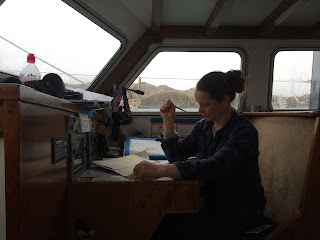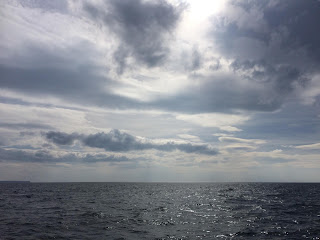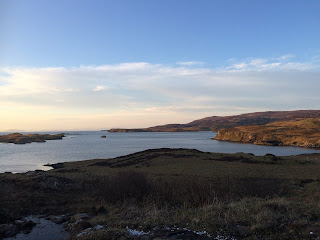Friday, 7 June 2019
The Whales Return
A friend was on a subsequent HWDT cetacean monitoring trip, in May, and they had 4 minke whales travelling with Silurian. So happy the whales returned after NATO had finished playing.
Monday, 15 April 2019
The Findings
 |
| Whale painting in Silurian |
We did hear sonar everyday, sometimes very loud. And we saw at least 7 military vessels of a possible 40-50 in the area. For the Hebridean Whale and Dolphin Trust the lack of cetaceans in the presence of so much sonar is indicative that the noise is driving the resident populations elsewhere, This may not be such a problem for the larger whales and dolphins, however for the smaller harbour porpoises they are being driven from their foraging grounds, possibly for 2 weeks. This could be serious.
It is unknown whether sonar affects resident fish, however if it does, it could therefore be affecting the local bird colonies who depend on the fish stocks.
There will be many more expeditions over the coming months to monitor the local cetaceans, without the presence of NATO, hopefully the whales and dolphins will return.
The Science
 |
| Route |
 |
| Phone App showing ships with AIS signals, including some military vessels, although most had their AIS off. |
 |
| On deck scanning the seas for cetaceans |
 |
| Relaying sightings or cetaceans to science desk below, and keeping a record of sea birds and ships |
 |
| Science desk, recording sightings, acoustics and environmental conditions on 'Logger' |
 |
| Logger, sightings page - there were 8 different pages for recording information |
 |
| Joint Warrior Survey report from 2018 |
The Volunteers
 |
| me on cetacean lookout |
 |
| Rachel - from New York state, studying animal care in Aberdeen |
 |
| Kirsten, Scottish, just finished Marine Biology Degree |
 |
| Ruadhan, Scottish, studying Marine Biology |
 |
| Nikki, from South Africa, working in Shetlands laying cables |
 |
| Aisha, Cornish, studying Marine Biology |
Monday, 8 April 2019
Meet the Crew
Emma, 34, our skipper at the navigation station. Born and raised on Mull to a mussel farmer, apparently they are a lot of mussels growing up. She has spent her adult life sailing, recently for 18 months in Hong Kong taking prisoners out as part of a rehabilitation program. She said the plastic issue was beyond belief, so painful to see. Part of the issue now is that many adults in Hong Kong are not old enough to remember it being any different, it’s become normalised.
Becky our science lead. Only 28, she’s been doing this job for HWDT for a year, and I was very impressed. Excellent teacher; really knew her stuff, always cheerful, very inclusive and reassuring, always on the ball and inspired confidence. English born and bred, but traveled a fair bit.
Brian, the first mate and chief cook, also English. Pictured here on the rib, ferrying people to and from Silurian to shore at our anchorage sites, giving us a bit of land based exploration.Had years of experience sailing tall ships with young people. Incredibly hard worker, very diligent, particularly around cleaning, and phenomenal baker - the vegan focaccia, soda breads and lemon cake were
excellent.
Chris, English, experienced marine mammal watcher, volunteer science lead and general kitchen mate. Incredibly knowledgable about wildlife, and to the crew’s surprise and gratitude, military shipping vessels.
Silurian
 |
| the galley |
 |
| my bunk room |
 |
| the heads |
 |
| saloon and science station to left |
Sunday, 7 April 2019
Sunday
Sad farewells to our little ‘family’. We had an hour or so to look round Tobermory when we arrived yesterday before deep cleaning the boat (not the bilges, thank goodness - remarkably dry bottom compared to Sea Dragon) and all had showers at the marina (limited water on board, so only one ship’s shower each during the trip) and then went out for a meal together. After breakfast together this morning Becky gave us a little slide show of memorable photos - unfortunately her computer went weird so we didn’t get to see the presentation of photos, data and charts etc that she had prepared for us, however we’ll get that individually soon (which should be great for doing talks).
I think some of us were a bit disappointed that we didn’t see any whales or dolphins and only a few harbour porpoises and seals. However, for the Hebridean Whale and Dolphin Watch the absence of sightings during the NATO exercises was highly significant. It’s rare not to see dolphins and whales normally.
We did find this Whale vertebrae on Sanday, probably from a juvenile.
I was curious as to what happens to these creatures during the exercises, where have they gone? What impact does having to leave make on both their own well being and on the areas they have abandoned.
Our science officer, Becky, two fees if the Minke Whales that would normally be arriving now, are delaying their arrival and the dolphins are just going somewhere else. She was concerned about the resident harbour porpoises; where are they going and how are they impacted by abandoning their normal foraging grounds for about 2 weeks? They’re not very big, an inability to feed for 2 weeks could have a big impact.
My other query was the impact on the affected areas of cetaceans being absent for two weeks or more. Becky wasn’t sure about this directly, however she pointed out that it is still unknown how sonar affects fish, and fish populations. If adversely, this would have a direct impact on the seabirds - and of course we are heading into breeding season.
As I was saying to one of the other volunteers, in a way it was good that we didn’t see the large sea mammals or numbers of smaller ones that should be present because it justified the purpose of our trip, it reinforced our hypothesis that the navy’s use of sonar is detrimental to local cetacean behaviour. Which is what we were there for and why we chose the Silurian Joint Warrior expedition rather than the whale and dolphin monitoring trips later in the spring and summer.
An unexpected experience for me was also around seeing the warships and reflecting on the reason for their presence. Although we only saw 7 ships (and several jets, couple of carrier planes and couple of helicopters) there may have been as many as 50 in the area (hard to tell as they have their AIS switched off ie they are in hiding). They come from about a dozen NATO countries converging on the Hebridean seas to play war games. This got me thinking why?
Who are our enemies? These warships would be useless against aliens so basically they are aimed at our fellow human beings. This seems bonkers in our current age of emigration and investments (how much of Britain is now owed by Russians, Chinese, Kuwait etc), international travel (how can people visit Russia or China as tourists and see them equally as enemies?), international commerce/employment and natural disasters where people are translocating world wide.
Back to my own work, the impact of plastics on sea life is now unquestionable, with sea bird hatchlings dying of starvation and dehydration, stomachs full of plastic, whales washed up on beaches around the world with stomachs full of plastic, almost all shell fish contaminated with mice plastics and the latest research on the presence and rapid uptake of nano plastics (nanometer sized) in scallops.
One of the most disturbing facts I learned on this trip is that the West highland’s coast community of Orcas haven’t produced any young for several years. An autopsy on a dead whale from the group revealed the blubber contained very high levels of persistent organic pollutants (POPs), notably PCB’s. We learned on eXXpedition two years ago that POPs mimic oestrogens and are chemically attracted to plastic particles. The west coast orcas are apex predators feeding largely on seals, which in turn are feeding on large fish which feed on smaller fish etc. Therefore, the orcas are bioaccumulating POPs that have made their way over years, possibly decades, up the food chain. The other resident population of orcas in the Hebrides eat mostly mackerel which will have accumulated less toxics due to shorter life spans and food chain.
I also hadn’t really appreciated that cetaceans are the bioengineers of our oceans, their behaviours and feeding basically ‘manage’ the marine ecosystems. Therefore, the health of cetaceans reflects the health of our oceans.
Standing on deck for hours every day, scanning the waters, provides plenty of time to reflect on the importance of our oceans. They cover most of our planet, they provide our drinking water, they connect to our bodies, they clean our air, they are the home of our distant mammalian relatives. Humans have always had a profound respect, and even communication with cetaceans. The recent interaction between Chris Packham and the grey whale on Blue Planet Live demonstrates that the relationship is probably reciprocated.
So I’ve come away with a whole wealth of experience and information to assimilate, share and build upon. I wonder what will be the next step?
Saturday, 6 April 2019
Saturday
We left Canna early this morning under very atmospheric dark skies and perfect sea conditions for spotting fins. Unfortunately we could still here the sonar, even louder than yesterday. Only one porpoise was heard on the sonar. We headed to an area called Hawes Bank where there is usually lots of cetacean activity, nothing!
The sonar did stop in the afternoon however still no cetaceans. The skies were amazing, and the views of the islands, stunning.
As we approached Tobermory, about 2pm, away from the more open water, we spotted a couple of harbour porpoises despite the sonar having returned. Two warships passed by the sound as we came in to anchor on the pontoon.
Friday
Beautiful day weather wise, with lots of sun and amazing cloud formations. We left Drunvegan bay and out into open sea, picking up increasing levels of sonar. The view of the snow capped black cuillins stayed with us for hours.
We saw a lot of birds, particularly razor bills, 520 were counted in one half hour shift!
Sonar showed military ships were relatively near by, with only one porpoise sounding.
After a few hours we came across the military, heralded by several aircraft flying overhead. We counted 5 ships altogether, 2 frigates, a destroyer, a supply ship and a marine assault ship; from different countries. Possibly up to 40 ships involved from many nations. The sonar was very loud until we left them far behind mid afternoon.
We continued round Skye, often managing to travel along a transects purely under sail. I got to helm under sail for an hour which was wonderful.
About 4pm we turned towards the Isles of Canna and Sanday and moored in a beautiful bay with a sandy beach.
All but the skipper went ashore (she stayed to cook 😆). I did a beach clean using the large bags and bins provided by the locals. Back to the boat at 8pm for our last evening meal on board and a game of 9 pieces of paper.
Today was probably the best food day. Porridge with my activated seeds for breakfast, fried mushrooms and vegan cheese on very nice white rolls for second breakfast, Chinese style ginger noodles for lunch, freshly made lemon cake for tea, sausages, mash, roast carrots and butternut squash with very mixed salad & avocado dressing for dinner.
With 3 vegans on board the food has been primarily vegan with sausages/bacon/eggs available at second breakfast for omnivores and some cheese at dinner. Other notable meals were a lentil dal with naan & fab salad and a homemade tomato based soup with freshly prepared focaccia. They say that as more and more volunteers are vegan they have decided to make their menu vegan with some extras for non vegans rather than vegan options.
Thursday, 4 April 2019
Thursday - Isle of Skye
All the sails up today on a port tack, with no engine. Glorious. Especially after a very rock & roll ride this morning heading into the force 7 northerly, with freezing drizzle. I felt quite seasick and happy to stand in the full brunt of the weather at the mast on lookout.
It was a very early start this morning and we travelled up the east coast of Skye and across the top, anchoring for the night in beautiful Dunvegan bay.
We’ve seen lots of sea birds, particularly while passing close by to the Shiants- uninhabited bird sanctuaries- guillemots, black guillemots, razor bills, fulmars, gannets, eider ducks, kittiwakes, various hills and puffins 😆. In this bay 2-3 common seals have come to look. Otherwise no marine mammal sightings or military ships 😏 We have heard their sonar and 3 fighter jets passed over.
After about 9 hours of working we moored on Skye and most of us went in the rib to the shore. The views from the small hill were glorious, of Silurian in the bay and the Black Cuillin Ridge snow pink in the setting sun.
As I write this Necky and Chris are checking today’s hydrophone recordings; already about a dozen harbour porpoises detected in this morning’s trace - we didn’t see any of them! But the sea state was pretty wild.
Silurian at anchor waiting for the rib to return
Wednesday, 3 April 2019
At anchor tonight in Churchton Bay, Raasay, looking out over the Isle of Skye.
Seas have been like roller coaster this afternoon. With atmospheric mountains on either side, snow peaked, in and out of cloud. No cetaceans, lots of birds, and our first military sighting, a submarine helicopter. We were passing over very deep water.
A highlight, passing under the Skye bridge, a contentious construction, bringing both income and more a lot more visitors to Skye.
Now drinking mulled wine while my dinner is being prepared. Fortunately 2 other vegans aboard so menu is vegan with optional local meat second breakfasts for everyone else.
 |
| Skye Bridge |
Really enjoying the colours of the hills
Wednesday 2
Wrapped up ready for watch duty
Tide behind us, but wind in front, tossing showers of salty water over us as we stand at the mast scanning the sea for any signs of marine mammals (and the buoys that act as creel markers - creels are lobster/crab/prawn pots).
We are 6 volunteers on a 3 hour rota. Half hour per session.
First session on starboard side of mast, scanning starboard front quarter. Second session on port side doing same. Third and fourth half hour sessions, time off to recuperate or sunbathe 😂
Fifth half hour session, on relay and bird/boat watch sitting by door relaying sightings from whale watchers and noting all seabirds & boats. Sixth half hour session down in science station logging weather/sea state and acoustic (we’re trawling a 100m hydrophone) information onto computer every 15 minutes and any sightings received from relay.
There are 4 crew. The skipper, Emma, First mate, Brian, Science officer, Becky and science/ship hand, Chris. Brian & Chris do breakfasts (two breakfasts 8am and 11am) & lunch, we do clear ups, boat cleaning and dinners. We’re not directly involved in the sailing, however we can do so during our ‘break’ if we like. I did some helming yesterday and Emma commented how good I was, must have been the excellent training on eXXpedition. We have sails up for stability, but using engine for power.
Wednesday 1
Sheltering in Sandaig bay, Loch Nevis, while a right hoolie blows (gale force 9 in open water). Making good use of the time playing ‘who am I?’ using cards with local sea mammals and birds.
We are 6 volunteers, all involved in marine studies; 4 marine biology students and a MMO (marine mammal observer). I asked everyone if they had their own research vessel (and funding etc), what would they research. Almost all said some aspect of whale research. Mostly studying the whales themselves, one studying the feed sources of whales.
This prompted me to ask ‘why whales?’ Why are whales important. Some great answers.
Like other apex species, such as tigers, looking after them naturally means their environment is looked after and preserved, ie our oceans.
Secondly, whales offer a unique service to the oceans’ nutrients: many whales dive incredibly deep to feed on squid etc which live on the ocean bottoms. Obviously whales need to surface to breathe, and as they do they defaecate, which provides an incredibly rich nutrient source for the micro organisms, such as plankton and krill. So whales are effectively bringing nutrients up from the ocean floor to the surface where they become available for other marine species.
The view of remote mainland (only accessible by boat or on foot) from the saloon
Tuesday, 2 April 2019
Boarding Silurian the Hebridean Whale and Dolphin Watch Research Vessel
For the Joint Warrior Survey April 1, 2019
6 Volunteers and 4 Crew
The famous colours of Tobermory reflected in the sunshine from our overnight mooring
Beautiful sunny morning with glassy sea, passing by Scottish Islands And Highlands
A full rainbow over Tobermory sees us off
On our way to find NATO warships doing their exercises, we scan the waters continuously for any sea mammals. We spot several harbour porpoises and common sealsa
The sunset in Sandaig Bay, our sheltered mooring for the night
Subscribe to:
Comments (Atom)


































